If something goes wrong in the German Bight, the German Bight Traffic Centre is the first to hear about it - and if the situation becomes really dramatic, it asks the Central Command for Maritime Emergencies in Cuxhaven to take over the overall management of a particular emergency.
Location
This is what happened last Tuesday, 31 January 2023, when the crew of the multipurpose freighter "Royal II", en route from Esbjerg to Cuxhaven with a cargo of wind turbine parts, reported an engine failure off Heligoland at 16:30 and the anchors would not hold in the storm. The "Royal II" (length: 132 m; width: 21 m; flag: Panama) was drifting at low speed with two anchors deployed about 2 nautical miles west of the 10 metre depth contour off Heligoland in the direction of the German Bight - and that in a wind force of about 7 Beaufort (50-61 km/h) from the northwest and a wave height of 4 metres. There were 20 people on board, but no dangerous goods.
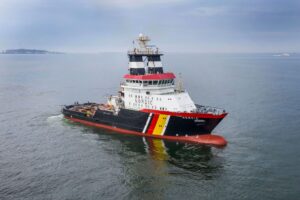
Measures
When there were no signs of an improvement in either the technical repairs or the nautical situation, the Traffic Centre in Wilhelmshaven handed the situation over to the Central Command for overall management at 18:00 - and a procedure that had already been tried and tested many times took its course:
- which stands on its permanent station in the German Bight Salvage tug "Nordic", which the federal government maintains for such missions, set course for the deployment site;
- the alarmed Towing Assistance Team (TAT) was soon able to fly to the casualty with a federal police helicopter for maritime emergency preparedness and set it down on board;
- For medical protection, a Emergency doctor and two Emergency paramedic of the Kiel fire brigade was flown to Helgoland in a naval helicopter to be close by in case help was needed;
- In addition, the Multipurpose vessel "Neuwerk" of the Cuxhaven Waterways and Shipping Office on its way to the scene of a possible pollutant accident.
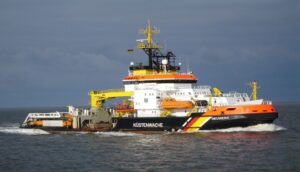
Procedure
The four-man TAT is specially trained to establish an emergency towing connection on ships that are unable to manoeuvre, even in adverse conditions. With the support of the two specialists on board the damaged vessel, it was possible to establish this from the "Nordic" to the "Royal II" shortly after 10 pm. This had been absolutely necessary - when the anchors were hoisted, it turned out that the chain had broken, resulting in the loss of one anchor and two of the second anchor's flukes being torn off.
Shortly afterwards - at around 22:20 - the crew of the "Royal II" was able to successfully complete the repair of the engine system after almost six hours of work and put it back into operation.
At around 11 p.m., the Central Command for Maritime Emergencies was able to hand back command of the "Royal II" situation to the German Bight Traffic Centre.
Conclusion
Even though everything had turned out well - which is not always to be expected - the "Nordic" stayed with the stricken vessel for safety reasons and towed it towards the sea when the wind died down.
Background
Traffic centres (www.wsv.de, www.elwis.de)
Traffic centres (Vessel Traffic Service Centre - VTSC) are the regulatory bodies of the river and shipping police authority (General Directorate for Waterways and Shipping - GDWS/ Waterways and Shipping Office - WSA). They lead the Maritime traffic safety with the measures traffic information, support, regulation and especially traffic guidance on the Kiel Canal. They also serve as emergency reporting centres.
All nine traffic centres on the German coast are manned 24 hours a day. Constant monitoring of shipping traffic and regular situation reports are part of the service. If necessary, safety messages are also broadcast to shipping.

General Average Command (www.havariekommando.de)
The Central Command for Maritime Emergencies is a joint organisation of the federal government and the five coastal states to ensure coordinated and joint accident management in the event of accidents in the North and Baltic Seas. It is based in Cuxhaven.
ARGE Coastal Protection (www.fairplay-towage.group)
In order to ensure optimum protection of the German coast, the federal government is demanding that in the event of a shipwreck in the North Sea and Baltic Sea Towing capacities are permanently available at sea and an equivalent replacement is provided as quickly as possible in the event of failure.
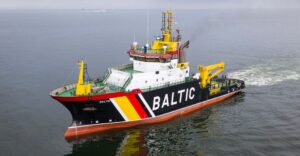
In 2001, the two tugboat shipping companies "Bugsier" and "Fairplay Towage" pooled their tugboat fleets in the "Arbeitsgemeinschaft Küstenschutz" (Coastal Defence Consortium) in order to be able to offer a suitable charter service to meet this demand. At the end of 2017, "Fairplay" took over the "Bugsier" shipping company and has since been offering its ARGE coastal protection services under the umbrella of the "Fairplay Towage Group" with a good 750 experienced employees and a total of around 100 powerful tugs of various sizes, including other specialised vehicles.
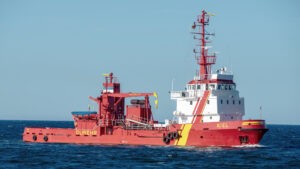
The Working Group for Coastal Protection currently provides the federal government with the emergency tug "Nordic" (201 tonnes bollard pull, sea position off Norderney) in the North Sea and the emergency tugs "Baltic" (127 tonnes bollard pull, Warnemünde station), the "Fairplay-25" (65 tonnes bollard pull, Sassnitz station) and the oil spill response vessel "Kiel" (based in Kiel) in the Baltic Sea.
Source: Federal Waterways and Shipping Administration, Havariekommando, ARGE Küstenschutz, thb - Täglicher Hafenbericht,

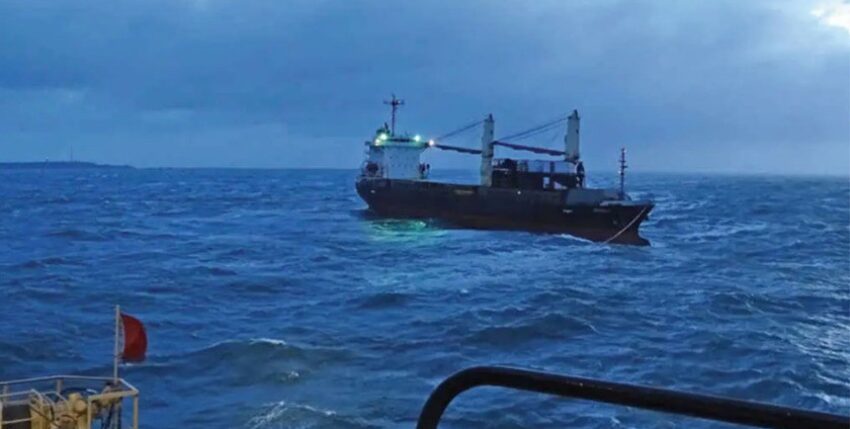









One Response
The emergency on the "Royal II" on 31 January 2023 (engine failure, emergency towing, assistance) and its handling under the direction of the Central Command for Maritime Emergencies (CCME) sounds good at first glance, and nothing happened.
But the processes are not optimally organised. Time was wasted. The damage report was received by the WSV's traffic centre at 16:30. The centre "checked" and passed the case on to the CCME for processing at 18:00, which was then carried out immediately and was successful. This shows once again that the CCME does not "live in the situation". This is not the first time such incidents and accidents have been reported.
All maritime emergency experience tells us that the first few hours ("the golden minutes") are decisive in determining whether an accident develops into a disaster or not, and that countermeasures must be initiated at the earliest possible point in time (not after a lengthy "examination"). To optimise accident management, the reporting channels in the CC should be concentrated. The current situation in which the CC may only take action after the occurrence and determination of a complex damage situation or at the request of other departments is not optimal
says Uwe Jenisch, Kiel